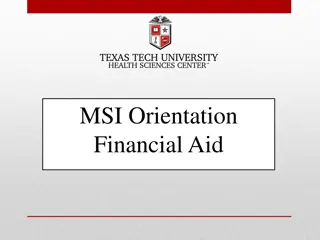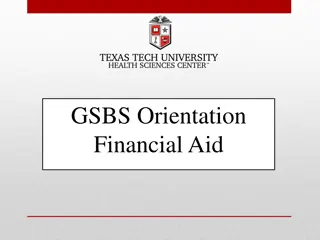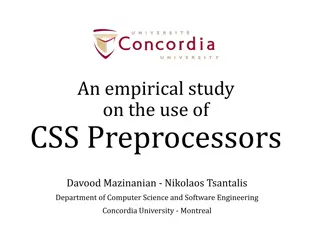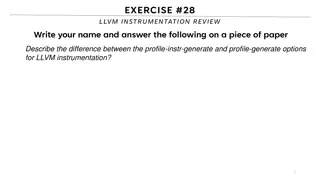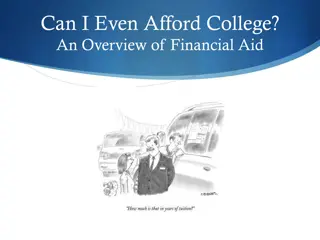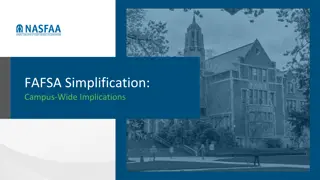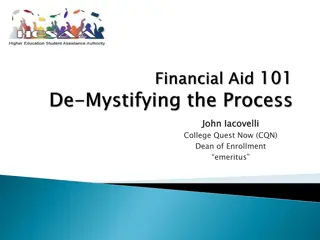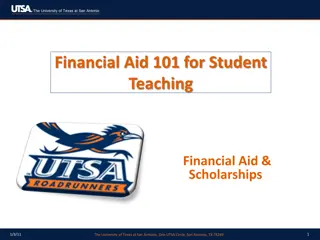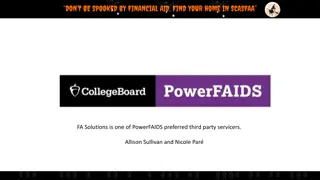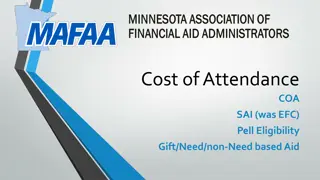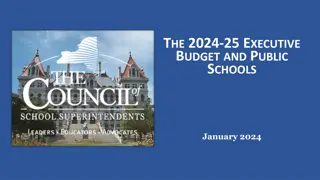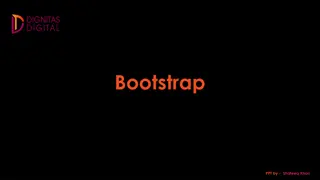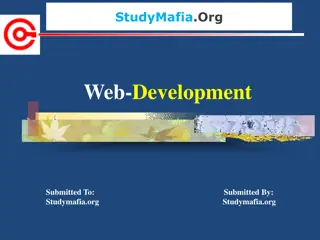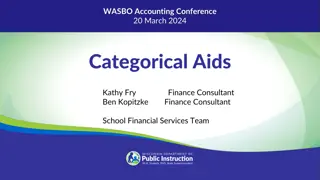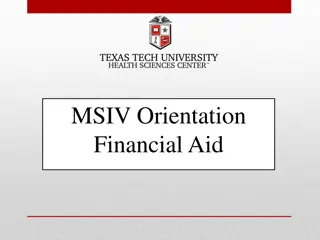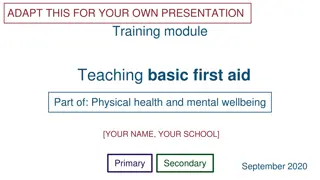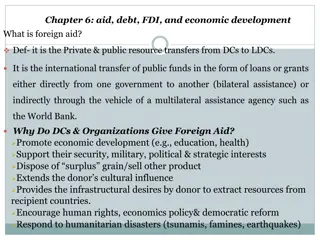Understanding Financial Aid Application: FAFSA vs. CSS Profile
Exploring the key differences between FAFSA (Free Application for Federal Student Aid) and CSS Profile forms for college financial aid. Learn about their purposes, institutions' preferences, application process, and cost considerations for families. Gain insights into navigating the complexities of financial aid applications effectively.
Download Presentation

Please find below an Image/Link to download the presentation.
The content on the website is provided AS IS for your information and personal use only. It may not be sold, licensed, or shared on other websites without obtaining consent from the author. Download presentation by click this link. If you encounter any issues during the download, it is possible that the publisher has removed the file from their server.
E N D
Presentation Transcript
WELCOME! WELCOME! Your microphone will be muted throughout the workshop. You may choose to have your video on or off. Please Rename yourself as follows: First Last Institution If you have questions for the presenters: Please type them in the Chat area. Any not answered during the presentation will be answered at the end as time allows. Evaluation, PowerPoint, and any Handouts(files): will be in the Chat area at the end of the presentation. This workshop will be recorded. (Posted in Member area of the PACAC website in a week.) **Any attendee who completes the entire workshop today will receive a Certificate of Completion AND a link for the ACT 48 credit request form to be submitted within 25 days of the event. **
Professional Professional Development, Development, Collaboration, Collaboration, Advocacy, Advocacy, Support, Support, Friendship Friendship
As with all PACAC Presentations, the inclusion of any presenter or content is not an endorsement by PACAC or any of its representatives.
PACAC Connects Financial Aid 2020: A Detailed Look Ruth Cramer Senior Associate Director of Financial Aid Dickinson College December 3rd, 2020
Principles of Need Analysis Principles of Need Analysis Parents and students share primary responsibility for paying college costs to the extent that they are able. Need analysis measures a family s ability to pay, which might be different from what they expect to pay. The calculated family contribution reflects the ability to absorb educational expenses over time, not just what they should be able to pay from current income.
FAFSA vs. CSS Profile Form FAFSA vs. CSS Profile Form FAFSA (Free Application for Federal Student Aid): Application for federal grants, student loans, work on campus, and state grants. Many colleges and universities use to award their need-based grants. No application fee IRS Data Retrieval Tool is a great way to populate most of the income information. CSS Profile: College Scholarship Service Required by nearly 400 colleges, universities, and scholarship organizations Used to equitably distribute limited institutional dollars Collects more information than the FAFSA Participating institutions can customize with additional questions and use the data differently The family pays application fee, which can be waived if they meet certain income guidelines. Both applications available October 1
Divorced/Separated/Never Married Parents Divorced/Separated/Never Married Parents Who is the Custodial Parent? The parent with whom the student lived the most in the past year. If both parents equally, the parent who provided the greater amount of financial support in the past year. If both parents equally, the parent who claimed the student as an income tax exemption in 2019. Both the FAFSA and CSS Profile should reflect the custodialparent s financial information.
Household B CSS Profile (Noncustodial) Household B CSS Profile (Noncustodial) Some institutions require financial information from both parents. Expectation that both parents financial circumstances should be considered, regardless of their marital status, before calculating need-based institutional grant eligibility. The noncustodial parent completes a separate CSS Profile form, which is then linked to the student s record. If the student has no relationship with the noncustodial parent, a Household B Profile Waiver is available at cssprofile.org. Some schools use their own waiver form Must submit supporting documentation Submitting a waiver request is not a guarantee that it will be granted.
Federal vs. Institutional Methodology Federal vs. Institutional Methodology Federal Methodology (FM) National formula overseen by the US Department of Education. Rationing device rather than a true evaluation of a family s ability to pay. Institutional Methodology (IM) National formula overseen by financial aid professionals. Used to calculate a family s expected contribution for need-based institutional grant consideration. Resulting family contribution is often different from the FAFSA EFC: Can be higher OR lower. This will be the need the institution will meet.
Income Income Both the FAFSA and CSS Profile collect prior-prior year parent and student income information: 2019, for the 2021-22 academic year Although families report 2019 income information, they are instructed to report current asset information and household size/number in college for the upcoming academic year. Families should contact financial aid offices if 2019 income no longer reflects their circumstances. Not unusual in light of the pandemic!
Taxable Income Taxable Income BOTH FM and IM: Adjusted gross income Wages/Earnings IM ONLY: Separate Line Items for: Interest & dividend income Capital gains or losses Business income or loss Rental income or loss/royalties Taxable IRA, pension, annuity distributions Income or loss from partnerships & S Corporations
Untaxed Income Untaxed Income BOTH FM and IM: Untaxed interest income Payments to IRA s & tax-deferred pension plans Untaxed portion of IRA and pension distributions Child support received Value of employer-provided housing (e.g., clergy, military, education professionals) Veterans noneducation benefits Bills paid on the student s behalf IM ONLY: Social security benefits Foreign income exclusion Value of on-base Military housing Bills paid on the parents behalf
Income Exclusions Income Exclusions BOTH FM and IM: Education tax credits Child support paid Taxable financial aid, like work-study earnings Combat pay
Income Protections & Allowances Income Protections & Allowances BOTH FM and IM: A portion of family income for necessities Based on household size and number in college US taxes paid FICA Tax State/other taxes IM ONLY: Unreimbursed medical/dental expenses exceeding 5% of income Annual allowance to recognize parents are also saving for younger siblings anticipated college costs
Assets Assets BOTH FM and IM: Current balance of parent and student cash, savings, & checking accounts Investments & investment property Real estate, mutual funds, trust funds, stocks, bonds 529 savings plans, prepaid tuition plans Business Equity (if more than 100 employees) Farm Equity (if family does not live on the farm)
Assets Assets IM ONLY: Home equity Business equity (regardless of the number of employees) Farm equity (even when family lives on the farm) Parental assets held in the name of younger children NEITHER ANALYSIS: Qualified retirement savings Life insurance Section 529 plans held by others (although distributions count as the student s future untaxed income, as bills paid on the student s behalf)
Asset Allowances Asset Allowances IM Only: Protection for cumulative savings for future education costs (recognition that parents must also save for younger siblings who might also plan to go to college) Protection for emergency expenses Protection for lower income families who may rely on assets to supplement income FM Only: Education savings and asset protection allowance Based on age of older parent
Tips for Success Tips for Success Advise students to meet the earliest application deadline among the schools they are considering. Ensure consistency on the FAFSA and CSS Profile Encourage families to consider completing the CSS Profile first! Some questions are worded in greater detail on the CSS Profile but should result in the same answers. Any discrepancies may delay the process if the school must contact the family for clarification. Check for required documentation and how to submit. Could be different for each school.
Why Might Students receive very Different Why Might Students receive very Different Financial Aid Offers from Similar Schools? Financial Aid Offers from Similar Schools? Consideration of Noncustodial Parent s Information Treatment of Older Siblings in Graduate School Treatment of Siblings Enrolled Less than Full-Time and/or at Lower-Cost Institutions Consideration of Tuition Costs for Younger Siblings in Private Elementary or Secondary School Consideration of Educational Loan Indebtedness Allowance for Residence in a Higher Cost of Living Area Differing Treatment of Home Equity Adding Back Business Losses and/or Depreciation Preferential Packaging No-Loan Packages Merit vs Need
Merit vs. Need Merit vs. Need Merit: Based on a student attribute Academic Athletic FAFSA / CSS Profile Form may or may not be required Need: Based on financial need Make sure families understand the difference when reviewing financial aid packages, as well as conditions for renewal.
Grants and Scholarships Grants and Scholarships Free money: no expectation of repayment Available from Federal and State governments, from the college/university, and from outside organizations
Work Work- -Study Student employment programs available from Federal and (sometimes) State governments, college/university Study Some institutions offer student employment regardless of need, although students demonstrating need might have first hiring preference. Best to think of work-study as a way to earn spending money for incidentals rather than a means of paying toward student account.
Student Loans Student Loans Federal Direct Subsidized and Unsubsidized Loan Program Subsidized: Based on Need. No interest accrues while enrolled and for 6 months after graduation Max: $3,500 first year / $4,500 sophomore / $5,500 junior & senior Cost of Attendance FAFSA EFC Other Financial Aid Unsubsidized: NOT Based on Need. interest accrues while enrolled Same base maximums, plus $2,000 Interest rate is set each July 1 Currently 2.75% (Cannot exceed 8.25%) Two disbursements: fall and spring
Parent Loans Parent Loans Federal PLUS (Parent Loan for Undergraduate Student) Parent borrows for student US Department of Education is the lender Parent borrower must not have an adverse credit history Max Loan = Cost of Attendance Financial Aid Interest rate is reset each July 1 Currently 5.30% (cannot exceed 10.5%) Two disbursements: fall and spring Repayment begins 60 days after fully-disbursed (typically in March of the academic year
Alternative Loans Alternative Loans The student is the borrower. A co-signer (typically parent) is required. Available from banks rather than the US Department of Education. A FAFSA is not required, but it s wise to exhaust all other possibilities first. Interest is fixed or variable, dependent on the co-signer s credit score and income. Max Loan = Cost of Attendance Financial Aid These are the loans you are likely to hear about in the media.
Sample Financial Aid Packages Sample Financial Aid Packages Tuition/Fees $55,000 $20,000 Room/Meal Plan 14,000 13,000 Books/Supplies 1,300 1,300 Personal/Transportation 1,900 1,900 Cost of Attendance $72,200 $36,200 EFC (Est Family Contribution) -15,000 -15,000 Need (Eligibility) $57,200 $21,200 Work-Study -2,500 -2,500 Student Loan -3,500 -3,500 Grant/Scholarship $51,200 $15,200
Colleges & Universities may have Very Colleges & Universities may have Very Different Abilities to Meet Students Need Different Abilities to Meet Students Need Need Blind Need Aware Gapping Admit/Deny
Special Circumstances Special Circumstances Counsel family to contact the Financial Aid Office early in the process rather than waiting until the student has been admitted. By waiting, the college might not have as much money available. More information is better than too little! Income Reduction Dependency Status Overrides Undocumented Students
Net Price Calculators: Encourage your Students Net Price Calculators: Encourage your Students to use them! to use them! All colleges and universities must provide a tool for families to project financial aid eligibility. If not immediately apparent, type Net Price Calculator in the Search box on the school s website. Designed to provide a fair estimate of eligibility for one year of full-time enrollment. Best to have most recent 1040, W-2 s, bank statements handy My InTuition: quick ballpark estimate based on just 6 questions. But, GIGO
Breakout Room Discussion Breakout Room Discussion You will be divided into breakout rooms of 6-8 people for your discussion. Please pay attention to your breakout room number. We ll ask each room to pick a representative who will report out to the entire group some of the highlights of your discussion. We encourage you to have your camera on and really lean in to these conversations! What are the questions/unique challenges around Financial Aid this year? How can we address these as we try to make higher education a possibility for all of our students?
What are Colleges & Universities Grappling With? What are Colleges & Universities Grappling With? Families income uncertainty: both incoming and returning students Gap semesters and years High-need students are becoming much needier as a result of the pandemic Leaves of absence and student loan repayment
Please use the **Evaluation** link in the Chat to complete the short survey. (The PPT & any handouts(files) are available for download in the Chat.) More PACAC Connects workshops every 1st Thursday of the month!! *Plus* Promoting Inclusivity & Equity, Lunch & Learn Series - 3rd Tuesday of every month!! Learn more: https://pacac.memberclicks.net/online-workshops





